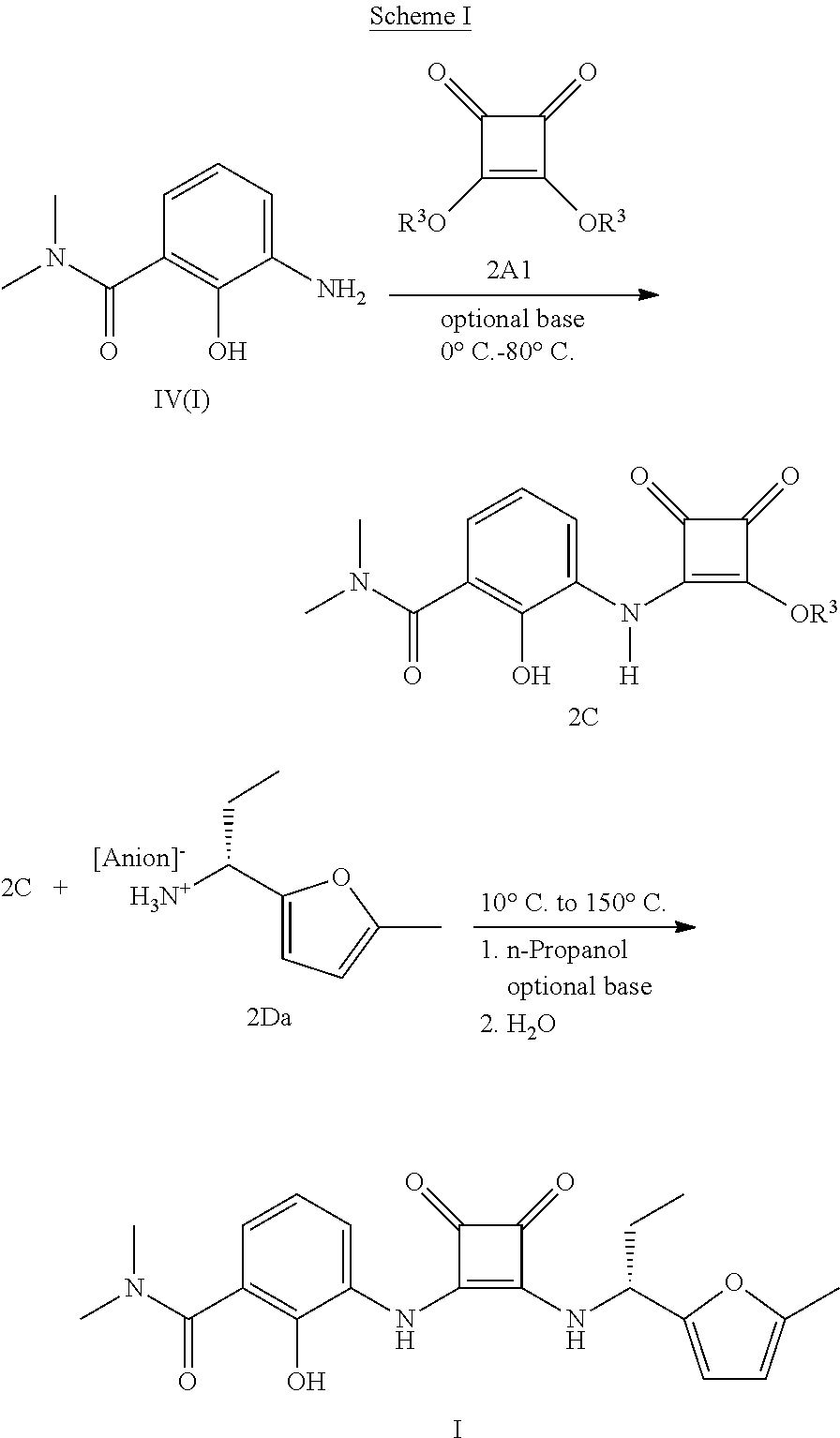Process and intermediates for the synthesis of 1,2-substituted 3,4-dioxo-1-cyclobutene compounds
a technology of dioxobutene and 1,2 substitutions, applied in the field of new products, can solve the problems of large amount of impurities, difficult handling, storage and shipping, and unadmixed level of impurities, and achieve the effect of convenient handling and obtaining
- Summary
- Abstract
- Description
- Claims
- Application Information
AI Technical Summary
Benefits of technology
Problems solved by technology
Method used
Image
Examples
examples
[0117]Unless otherwise specified, all reagents are articles of commerce, food grade or pharmaceutical grade, and used as received.
[0118]Example Ia
In Situ Preparation of Dimethyl Squarate (2A2) and Reaction With Compound (2B) to Form Compound (2Ca)
[0119]
[0120]Into a 50 gallon glass reactor equipped with a thermocouple, N2 inlet and feed tank was charged 9.5 kg of the compound of Formula 2A. The reactor was then charged with 65 liters dry methanol (Karl Fischer titration “KF” indicates water present at <0.1%) followed by 20 liters trimethylorthoformate and 0.2 kg trifluororacetic acid. The reaction mixture was heated to reflux and maintained for about one hour. The reaction mixture was concentrated at one atmosphere until the internal temperature exceeded 70° C. The reaction mixture was maintained at reflux for about four hours then the temperature was adjusted to a temperature between 40° C. and 50° C. The reactor was charged with 26 liters dry methanol and the reaction mixture tempe...
example ib
Preparation of the Compound of Formula (2Ca) from Commercial Dimethyl Squarate (2A2)
[0123]Charge 6.3 grams of the compound of Formula 2A1 (Aldrich, used as received) and 5.0 grams of the compound of Formula I to 250 ml round bottom flask equipped with a thermocouple, N2 inlet and addition funnel. Charge 41 ml dry methanol (KF<0.1%). Adjust the batch to temperature between −5 and 5° C. Over about 5 hours, charge 4.9 ml (0.98×) triethylamine (TEA) to the batch while maintaining the batch at a temperature between −5 and 5° C. After the addition of TEA is complete, agitate the batch for about one hour at a temperature between [−5° C.] and [+5° C.]. Charge 2.8 ml acetic acid while maintaining the batch at a temperature between [−5° C.] and [+5° C.]. Adjust the batch volume to 63 ml by adding dry methanol. Heat the batch to reflux and maintain for about 15 minutes. Adjust the temperature to about [−5° C.] and [+5° C.] over about 1 hour. Filter the batch and wash the filter cake with 25 ml...
example ic
Preparation of the Compound of Formula (2Ca) from Commercial Diethyl Squarate (2A3)
[0124]
[0125]Charged 44.0 kg of the compound of Formula I, 225 kg dry ethanol and 41.8 kg of the compound of formula II to a 300 gallon glass lined reactor equipped with a thermocouple. N2 inlet and feed bottle. Adjusted the batch to temperature between 0 and 10° C. Over about 1 hour, charged 17.1 kg triethylamine (TEA) to the batch while maintaining the batch at a temperature between 0° C. and 10° C. After the addition of TEA was complete, agitated the batch for about three hours at a temperature between 0° C. and 10° C. Over about 3 hours, charged additional 8.2 kg triethylamine (TEA) to the batch while maintaining the batch at a temperature between 0° C. and 10° C. After the addition of TEA was complete, agitated the batch for about three hours at a temperature between 0° C. and 10° C. Charged 19 liters acetic acid while maintaining the batch at a temperature between 0° C. and 10° C. Adjusted the ba...
PUM
| Property | Measurement | Unit |
|---|---|---|
| Temperature | aaaaa | aaaaa |
| Temperature | aaaaa | aaaaa |
| Temperature | aaaaa | aaaaa |
Abstract
Description
Claims
Application Information
 Login to View More
Login to View More - R&D
- Intellectual Property
- Life Sciences
- Materials
- Tech Scout
- Unparalleled Data Quality
- Higher Quality Content
- 60% Fewer Hallucinations
Browse by: Latest US Patents, China's latest patents, Technical Efficacy Thesaurus, Application Domain, Technology Topic, Popular Technical Reports.
© 2025 PatSnap. All rights reserved.Legal|Privacy policy|Modern Slavery Act Transparency Statement|Sitemap|About US| Contact US: help@patsnap.com



